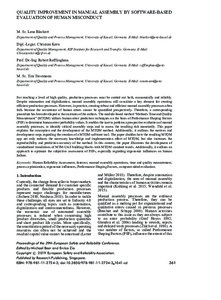| dc.date.accessioned | 2021-08-24T11:47:52Z | |
| dc.date.available | 2021-08-24T11:47:52Z | |
| dc.date.issued | 2019 | |
| dc.identifier | doi:10.17170/kobra-202105033801 | |
| dc.identifier.uri | http://hdl.handle.net/123456789/13157 | |
| dc.description | Proceedings des Kongresses "European Safety and Reliability Conference ; 29; 2019; Hannover / ESREL ; 29; 2019; Hannover" | ger |
| dc.language.iso | eng | eng |
| dc.publisher | European Safety and Reliability Association | |
| dc.rights | Urheberrechtlich geschützt | |
| dc.rights.uri | https://rightsstatements.org/page/InC/1.0/ | |
| dc.subject | Human Reliability Assessment | eng |
| dc.subject | forecast | eng |
| dc.subject | manual assembly operations | eng |
| dc.subject | time and quality measurement | eng |
| dc.subject | process optimization | eng |
| dc.subject | ergonomic influences | eng |
| dc.subject | Performance Shaping Factors | eng |
| dc.subject | computer aided evaluation | eng |
| dc.subject.ddc | 620 | |
| dc.title | Quality Improvement In Manual Assembly By Software-Based Evaluation Of Human Misconduct | eng |
| dc.type | Konferenzveröffentlichung | |
| dcterms.abstract | For reaching a level of high quality, production processes must be carried out both, economically and reliably. Despite automation and digitalization, manual assembly operations still constitute a key element for creating efficient production processes. However, in practice, creating robust and efficient manual assembly processes often fails because the occurrence of human errors cannot be quantified prospectively. Therefore, a corresponding procedure has been developed at the institutes of the authors. The module-based method “Methods Time and Quality Measurement” (MTQM) utilizes human error prediction techniques on the basis of Performance Shaping Factors (PSF) to determine human error probability values. It enables the user to perform a prospective evaluation of manual assembly processes, to identify critical assembly steps and to assess the resulting risk monetarily. This paper explains the conception and the development of the MTQM method. Additionally, it outlines the motives and development steps regarding the creation of a MTQM software tool. The paper clarifies how the resulting MTQM app not only reduces the necessary knowledge and implementation effort of MTQM, but also increases the reproducibility and prediction accuracy of the method. In this context, the paper illustrates the development of standardized translations of MTM-UAS building blocks with MTQM standard words. Additionally, it outlines an approach to optimize the subjective assessment of PSFs, especially regarding ergonomic influences on human failure. | eng |
| dcterms.accessRights | open access | |
| dcterms.creator | Blackert, Lena | |
| dcterms.creator | Kern, Christian | |
| dcterms.creator | Refflinghaus, Robert | |
| dcterms.creator | Trostmann, Tim | |
| dc.publisher.place | [Europe] | |
| dc.publisher.place | Singapore | |
| dc.relation.doi | doi:10.3850/978-981-11-2724-3_1041-cd | |
| dc.subject.swd | Zuverlässigkeit | ger |
| dc.subject.swd | Herstellung | ger |
| dc.subject.swd | Technische Sicherheit | ger |
| dc.subject.swd | Faktor Mensch | ger |
| dc.subject.swd | Prozessoptimierung | ger |
| dc.subject.swd | Montageablauf | ger |
| dc.type.version | publishedVersion | |
| dcterms.source.collection | Proceedings of the 29th European Safety and Reliability Conference (ESREL) : 22-26 September 2019, Hannover, Germany | eng |
| dcterms.source.editor | Beer, Michael | |
| dcterms.source.editor | Zio, Enrico | |
| dcterms.source.identifier | doi:10.3850/978-981-11-2724-3 | |
| dcterms.source.identifier | isbn:978-981-11-2724-3 | |
| dcterms.source.pageinfo | 361-368 | |
| kup.iskup | false | |

